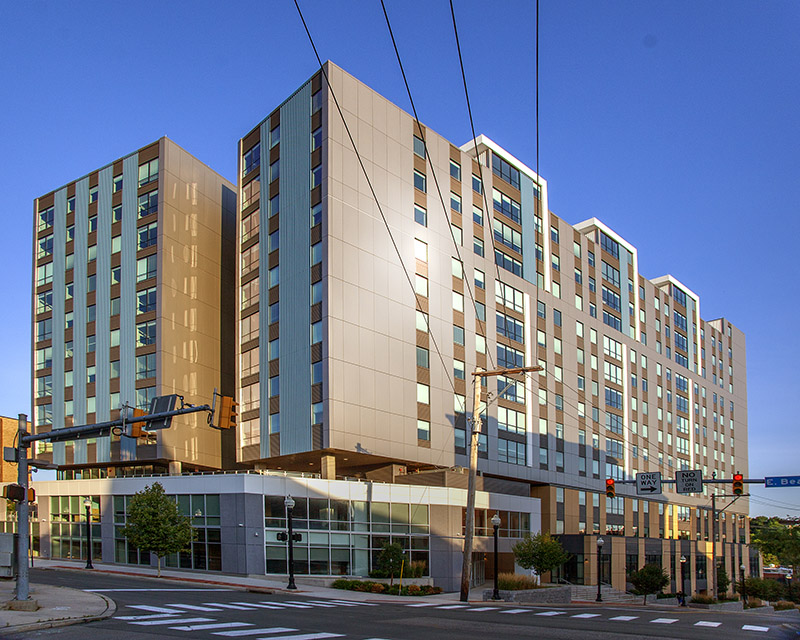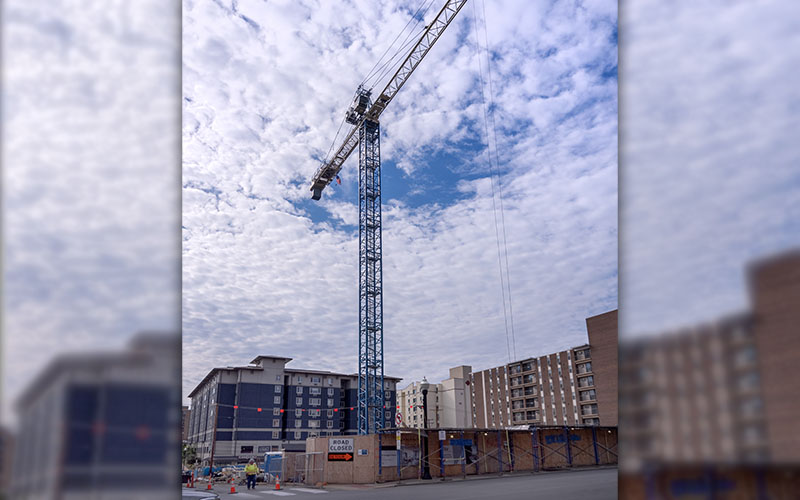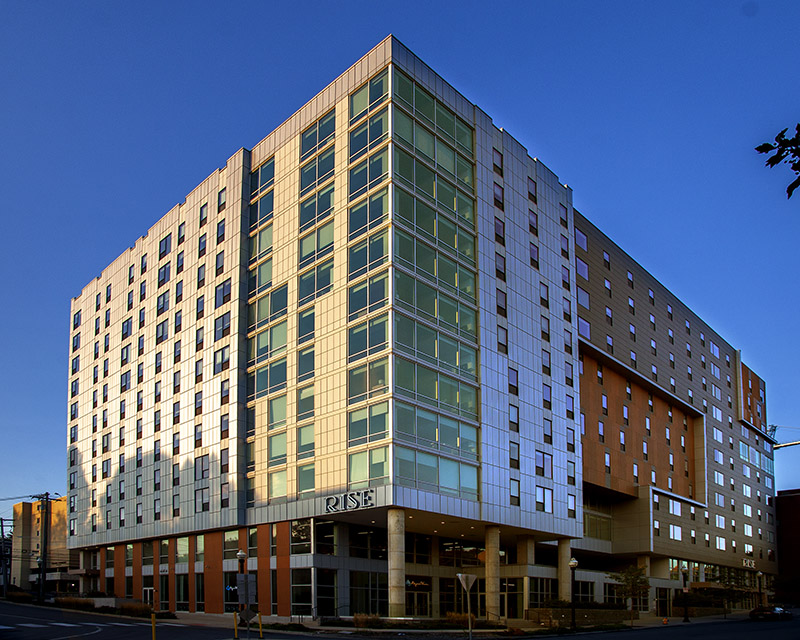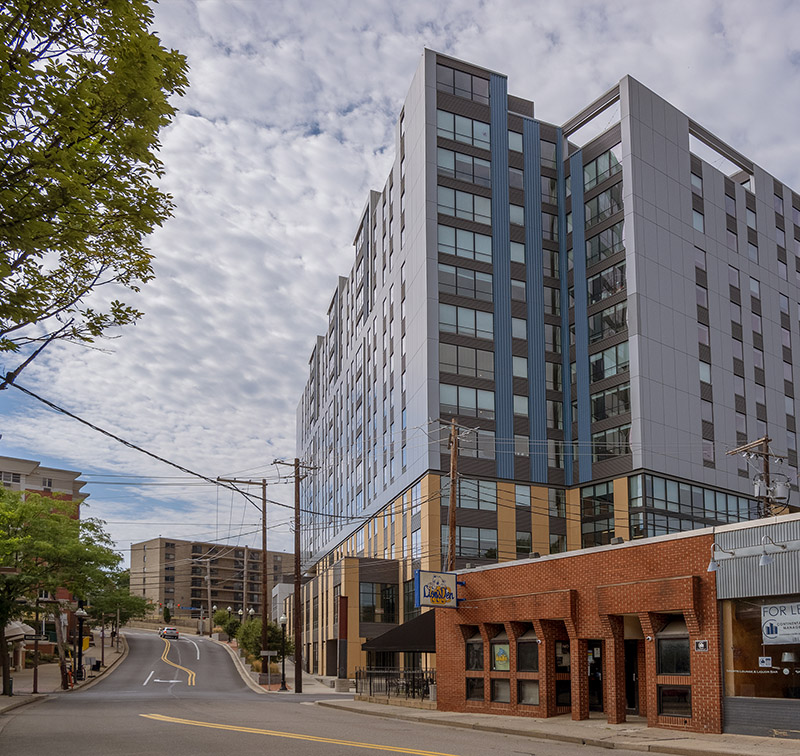By Gracie Mullan
 The HERE building seen from Beaver Ave and Garner Street. Image: Chuck Fong.
The HERE building seen from Beaver Ave and Garner Street. Image: Chuck Fong.
With Penn State’s rapid growth in recent decades, faculty, staff, students and visitors continue flooding into Happy Valley. As you’d expect, both housing and visitor accommodations are areas that have required particular attention downtown.
According to the Downtown State College Improvement District, on average, 1.5 million to 2 million people visit the downtown area each year with the biggest numbers around football weekends and graduations.
This number will likely grow, as Penn State gears up for an extremely successful 2023 season in lieu of the 12-team expansion to the playoff system. On top of that, Beaver Stadium is also expecting a long-awaited $700 million renovation set to be finished by 2027 as part of the overall $2.183 billion university 2024-2028 capital plan.
Penn State evolved to meet the demands of a growing student population in recent decades. Then it was State College’s turn to decide how to create more living space.
A larger stadium with upgraded facilities means that even more alumni will likely be coming back during home football weekends to enjoy the brand-new stadium. Plus, visitors will continue to visit for events at other Penn State venues like the Bryce Jordan Center and Pegula Area and Eisenhower Auditorium.
Penn State evolved to meet the demands of a growing student population in recent decades. Then it was State College’s turn to decide how to create more living space. Because of zoning, new builds crept into surrounding townships, edging into residential districts and farmland.
Beginning in the early 2000s, the Borough of State College’s leadership saw the need for change, to keep student housing close to downtown State College and bring with it commercial and dining space.
 Construction of The ōLiv highrise next to The Legacy building on East College Ave. Image: Chuck Fong.
Construction of The ōLiv highrise next to The Legacy building on East College Ave. Image: Chuck Fong.
In one of Ed LeClear’s first campus roundtable meetings in 2014 as the Director of Planning and Community Development, along with Borough Council and members of UPUA (University Park Undergraduate Association), the student government at Penn State, LeClear heard requests from student leadership for three major categories for improvement: substandard housing, horrible living conditions, and a lack of new improved buildings.
“Because the zoning was what it had been in the 1980s and 1990s, growth of student residential housing was pushed out into the neighborhoods and townships,” LeClear said. Housing development follows where the market and regulations are, he explained.
“In the 1990s and 2000s in the region, it was permissive to build in the townships and not in the borough. There was a desire to maintain low-density student housing downtown. That changed in the 2000s. When I started in 2014, there had been a series of changes in 2005, 2007, and 2013 that created a zoning environment that allowed for larger buildings downtown with a much larger residential footprint. This coincided with a huge increase in purpose-built student housing nationally.”
The zoning changes, plus a shift in the national market, led to a developer interest in student housing with the regulations to be able to build in State College.
Because the zoning was what it had been in the 1980s and 1990s, growth of student residential housing, was pushed out into the townships.
The zoning ordinance that originally allowed the construction of highrises was agreed upon in 2005 in hopes of building the Fraser Center on West Beaver Avenue. That timeline was delayed by the 2008 Great Recession.
In 2013, a zoning amendment was passed which allowed the construction of the highrises lining the edges of College Ave. and Beaver Ave. with one condition, agreed upon in 2006 and 2007: two stories of commercial space had to be accommodated for in the construction plans.
(The 12-story Fraser Center, home to Hyatt Place Hotel, Federal Taphouse, Target, and Planet Fitness, was ultimately completed in 2016.)
In the years since then, the borough has leaned towards developing more student-living options downtown following the opportunities for student-housing investors that arose because of the 2008 recession.
“The vision from previous councils was that we need to increase taxpayers and revenue; we also have a need to improve our student housing stock,” LeClear said. “As you increase competition, the market tends to lead to rehabilitation and improvements in existing stock which we have seen.”
As a result, the downtown area now has seven highrises with one in construction and one in the permit phase.
There was a lot of logic to where we were going to build. The demand is downtown, the density is downtown so you can walk to campus. But we didn’t want to damage the heart of downtown.
The Metropolitan, built in 2017, was the first highrise student living apartment, opening the doors for more upscale living options downtown. The RISE and The EDGE followed shortly after in 2018.
The Maxxen opened in 2020, followed shortly by The HERE in late 2020. The Standard also finished construction in 2021.
Plans for another 12-story highrise are underway on East College Ave., called The Mark. The Mark is Landmark Properties’ most recent highrise project and is likely to be the last completed highrise downtown for the foreseeable future just a block away from the highrise currently under construction, The ōLiv.
 The RISE building on East College Ave. Image: Chuck Fong.
The RISE building on East College Ave. Image: Chuck Fong.
The placement of the highrises is strategic. TThe borough decided to create the zoning that would allow the construction of highrises in a large “U-shape” where the apartments would be on the outskirts of the main downtown street. Buildings would only go up on the edges of downtown. This way, the charming and unique atmosphere of downtown could be preserved.
“There was a lot of logic to where we were going allow the market to build. The demand is downtown, the density is downtown so you can walk to campus. But we didn’t want to damage the heart of downtown. Building around and up was a compromise to the market,” LeClear said.
As of right now, the only 12-story highrises that have been built are on the corner of College Ave. and Atherton St., and the corner of Beaver Ave. and Garner St.
The combined construction projects have increased student housing by more than 4,000 beds since 2016.
“Nothing else has been built above seven stories within that zone and that was on purpose,” LeClear emphasized.
Currently, there are no plans to change this trend, but the borough council is actively meeting to come up with a new vision for State College. One of the recent demands is to create three-to-five-story housing for non-students downtown.
“Based on our conversations with Council, I don’t think you are going to see any buildings more than five stories in the heart of downtown going forward,” LeClear said.
These highrises have greatly increased housing options for students and residents, which has resulted in a vibrant and successful downtown area. Most assume that the apartment buildings are solely for students, but the RISE offers two floors exclusively for young professionals and graduate students, which was specifically incentivized in the zoning.
The combined construction projects have increased student housing by more than 4,000 beds since 2016. This higher density of student living has brought more students downtown, increasing the increased tax base and providing more affordable housing with an increased quantity of apartment spaces.
 The HERE highrise on the former Garnet Street Lot, at the intersection of Calder Way and South Garner St.
The HERE highrise on the former Garnet Street Lot, at the intersection of Calder Way and South Garner St.
Image: Chuck Fong.
Increasing commercial space for dining and shopping
Under current regulations, developers must have two stories of commercial space in each building. Because of this regulation, a variety of restaurants and businesses have opened in the spaces including State College’s own KCF Technologies, Orangetheory, Tadashi restaurant, and more. In March 2023, a liquor license request was made by the owner of GLU Hospitality for the Philadelphia-based Firgo Italian which intends to open a location on the first floor of The Standard highrise. With the request for approval in May, the restaurant is on its way to Happy Valley. The first floor of The Standard is set to be the new home for a bagel shop as well, the latest in a number of welcome additions to the food options available downtown.
Only 83,336 of the over 300,000 square feet of retail space built or under construction in the new highrises is still available today.
“By this time next year when you look at The Standard, the only space that’s actually empty on the first floor is on the corner,” LeClear said.
According to LeClear, 300,000 square feet of retail space has been built or is under construction in the new highrises from 2016 to today. Only 83,336 square feet of retail space is still available today. This number is even more impressive since many companies have moved into commercial space in the three years since the COVID-19 pandemic began. These new businesses have greatly increased traffic downtown and many residents are able to enjoy new restaurants and amenities in the heart of downtown.
Actively combatting climate change
With the development of the highrises and renovation of older buildings, State College is well positioned for climate change going forward. The new buildings are much more energy efficient compared to the older buildings. The downtown area is easily walkable, and residents can meet almost all of their wants and needs by walking to a store downtown. The community also has access to public transportation via the CATA buses and the local airport. The community also has excellent schools including three walkable elementary schools all located within the borough and one of the best school districts in the state, the State College Area School District.
The Borough Council is actively meeting to come up with a planned vision for State College. According to LeClear, the community should expect a report in late 2023 for future plans.
“Our job from a zoning standpoint is to determine what the community wants and finetune that into something the market is willing to create. That’s the process we are in right now with council to figure that out,” LeClear said.
“We will be an adaptable community. I think we will be a welcoming community as climate change occurs. I think more people will move here because of the assets we have. We have a great competitive advantage going forward,” LeClear said.

